Analogue Multimeters
Best suited for those who prefer a traditional-style needle scale rather than a digital readout, our range of analogue multimeters come from world-renowed manufacturers such as Extech, DiLog and Chauvin Arnoux.
Find out more about Analogue Multimeters below.
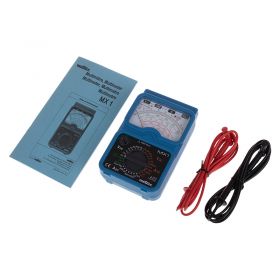
- Broken fuse indicator
- Withstand up to 400Vrms of input voltage
- Measures voltage levels up to 1500V
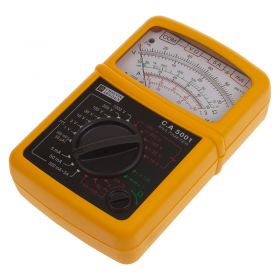
- Analogue scale
- Tests voltage, current, resistance and continuity
- Compact, shockproof case with built-in stand
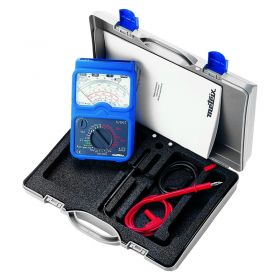
- Comes with its own tough carrying case
- Measures transient pulses up to 6kV
- Shock and water proof
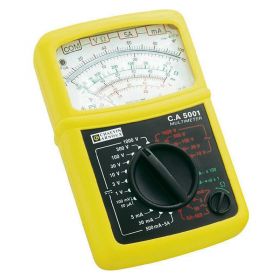
- High accuracy
- Portable and tough carrying case
- AC/DC voltage tests
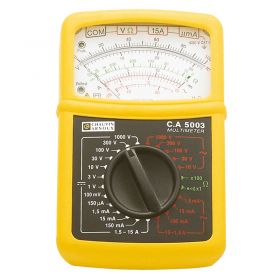
- Safety rating of IP53
- Accuracy of 1.5%
- Resistance measuring tests
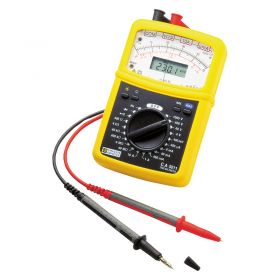
- Works even if signal is distorted
- Works well with AC/DC, frequency and resistance
- Maximum and hold functions
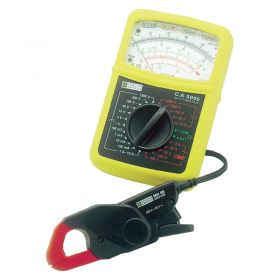
- Amp clamp included
- 1.5% accuracy
- AC and DC voltage measuring
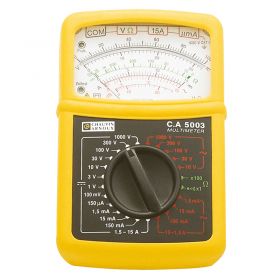
- Tough carrying case included
- Accuracy of 1.5%
- Automatic calibration feature
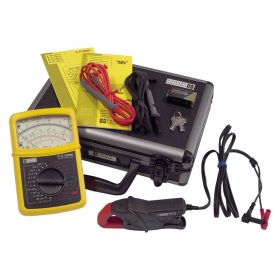
- Accuracy of 1.5%
- Works with AC and DC voltage
- Perfect for electricians and electro technicians
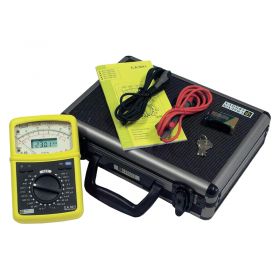
- Dual-readings: built-in analogue and digital screens
- True RMS accuracy
- Work hands-free with the built-in stand
About Analogue Multimeters
Multimeters are generally divided into two separate categories - analogue and digital. But what is the difference between the two?
The main difference - internally at least - is that an analogue multimeter uses electromechanical components to display measured values, whereas a digital multimeter uses electrical components to display measured values. This means that externally you will see different things; the analogue multimeter generally displays a reading on an analogue needle-pointer scale, while DMMs generally produce a reading represented as an exact digital number. It's like the difference between an alarm clock and a digital one - one uses hands, and the other uses measured numerical values to represent time. Multimeters are the same, except they measure parameters such as resistance, sound levels, and more instead of time.
An analogue multimeter is a device that measures two or more electrical properties and displays these measurements along a calibrated scale using a needle. Depending on the multimeter you are using it may have one or more calibrated scales visible and each scale generally represents different selector switch settings (such as AC, DC, and R) and jack usage (mA jack and 10A jack). It is important that whenever you take a measurement using an analogue multimeter you identify which scale is relevant to the parameter you are testing, otherwise you may gain incorrect readings.
This type of multimeter is generally used to measure voltage, resistance, and current levels, but there are other analogue models on the market that include additional scales/ranges for measuring such things as decibels and for checking the status of batteries.
Understanding the Scales
Analogue multimeters may use two different types of scales known as linear scales and non-linear scales. The difference between these two types of scale is that a linear scale is divided into equally spaced segments, whereas a non-linear scale is divided into unequally spaced segments. To help with further understanding of test readings a mirror is generally included on the display that reduces potential measurement errors if you're facing a different direction other than head-on to the multimeter (known as parallax).
As well as the type of scale you also need to understand how to use the scale effectively to gain a measurement. Digital multimeters generally make life a lot easier than analogue multimeters do as they automatically calculate and display a reading, but whenever you use an analogue multimeter you have to do a bit of work to get an exact reading.
The scale of any analogue multimeter is divided up into what's known as primary, secondary, and subdivisions. Understanding what each of these means is important to understand how an analog multimeter works, so:
- A primary division is a listed value - e.g. 1, 2, 3, etc
- A secondary division is a sub-section of a primary division - e.g. a half, quarter, or other value
- A subdivision is another further division of a secondary division, again divided into halves, etc
Both secondary and subdivisions do not have listed values - it is up to the user to calculate what the result is by using the primary division as a starting point. To get an exact reading from an analogue multimeter you have to gain a value of each division and total them together. To do so:
- Read the primary division and make a note
- As soon as the needle of the scale moves past a secondary division, make a note of that number
- Read the subdivision value (may require rounding to the nearest division)
- Add these readings together and you've gained a full analogue reading!
So basically if we added a primary division of 2.0, a secondary division of 0.5, and a subdivision of 0.3 we'd get an overall reading of 2.8. As we said previously this type of measurement is generally a lot harder to perform than using a DMM, but analogue multimeters are extremely useful for tracking sudden fluctuations in the parameter you're measuring, so are certainly worthy of use still in modern electrical testing scenarios.
Our Analogue Multimeter Range
Tester.co.uk stocks a selection of analogue multimeters from well-known manufacturers such as Chauvin Arnoux, Extech, and Kewtech. All of our products ship as standard with a manufacturer's warranty and additional accessories.
If an analogue multimeter doesn't sound right for you, we also highly recommend checking out our extensive product library of digital multimeters.


